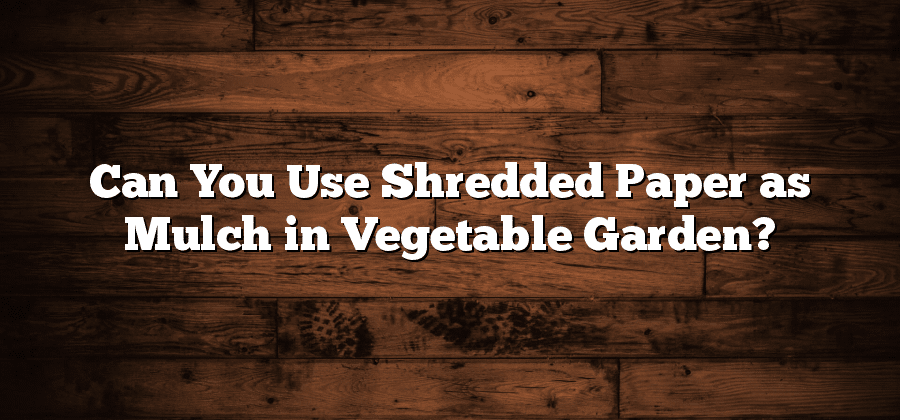Benefits of Using Shredded Paper as Mulch
Shredded paper mulch provides numerous benefits for gardeners and landscapers alike. One of the primary advantages is its ability to retain moisture in the soil. As the shredded paper mulch decomposes, it forms a protective layer over the soil, preventing water evaporation and helping to keep the soil consistently moist. This is especially beneficial for areas with dry or arid climates where water conservation is crucial.
In addition to its moisture-retaining properties, shredded paper mulch also helps to suppress weeds. By placing a layer of shredded paper over the soil, sunlight is blocked from reaching weed seeds and inhibiting their growth. This natural weed barrier reduces the need for manual weeding or the use of chemical herbicides, making it an eco-friendly alternative. Furthermore, shredded paper mulch breaks down slowly, providing long-lasting weed control and reducing the time and effort spent on maintaining weed-free garden beds.
Types of Shredded Paper Suitable for Mulching
The types of shredded paper suitable for mulching vary depending on the specific needs of your garden or landscaping project. However, there are a few general guidelines that can help you determine which shredded paper will work best for your purposes.
First and foremost, it is important to use paper that is made from non-toxic materials. This is particularly important if you are using the shredded paper mulch in vegetable gardens or around edible plants. Look for paper that is made from natural, organic materials and avoid using paper that has been treated with chemicals or dyes.
Additionally, the texture and thickness of the shredded paper can impact its effectiveness as mulch. Generally, finer-textured paper works best for smaller, more delicate plants, while coarser-textured paper is more suitable for larger plants and trees. It is also worth considering the moisture content of the shredded paper, as damp paper can help retain moisture in the soil.
By carefully selecting the types of shredded paper that are suitable for mulching, you can ensure that you are making the most of this eco-friendly and cost-effective gardening technique.
How Shredded Paper Mulch Affects Soil Health
Shredded paper mulch, when used correctly, can have a positive impact on soil health. One of the main ways it benefits the soil is through its ability to retain moisture. The paper acts as a barrier, preventing water from evaporating too quickly and allowing it to penetrate deeper into the soil. This is especially beneficial in dry climates or during periods of drought, as it helps to ensure that plants receive adequate hydration.
In addition to moisture retention, shredded paper mulch also improves soil structure. As the paper decomposes over time, it adds organic matter to the soil, which helps to create a more stable and fertile environment. This organic matter helps to improve soil drainage, enhance nutrient availability, and promote the growth of beneficial soil microorganisms. These microorganisms, in turn, contribute to nutrient cycling and overall soil health. By using shredded paper mulch, gardeners can create an environment that is conducive to the growth of healthy and productive plants.
Proper Application Techniques for Shredded Paper Mulch
Applying shredded paper as mulch in your garden is a great way to recycle waste while also benefitting your plants. However, it is important to follow proper application techniques to ensure optimal results. Firstly, ensure that the shredded paper is properly composted and free from chemicals or harmful substances. This will prevent any unwanted toxins from seeping into the soil and potentially harming your plants. Secondly, before applying the shredded paper, remove any existing weeds or grass from the area to prevent them from growing through the mulch. This will help with weed control and ensure that your plants have the best chance of thriving in a weed-free environment. Follow these techniques, and you will be well on your way to successfully using shredded paper mulch in your garden.
When applying shredded paper mulch, another important factor to consider is the depth. It is recommended to apply a layer of shredded paper mulch that is around 2 to 3 inches thick. This thickness will provide adequate coverage and insulation for your plants while also allowing for proper aeration and water absorption. Keep in mind that applying a thicker layer may lead to excessive moisture retention, which can potentially harm your plants. On the other hand, a thinner layer may not provide enough protection and insulation. Therefore, it is crucial to find the right balance in order to promote healthy plant growth. By following these application techniques, you can ensure that your shredded paper mulch is used effectively in your garden.
Ways Shredded Paper Mulch Helps with Weed Control
Shredded paper mulch serves as an effective weed control solution in several ways. Firstly, it provides a physical barrier that prevents the growth and emergence of weeds. The thick layer of mulch covers and smothers weed seeds, preventing them from receiving sunlight and impeding their germination. This way, shredded paper mulch acts as a protective shield, keeping weeds at bay and minimizing the need for frequent weeding.
Moreover, shredded paper mulch aids in moisture retention, which indirectly contributes to weed control. By creating a moisture-rich environment, it supports the growth and development of desirable plants while suppressing the growth of weeds. Weeds thrive in dry and arid conditions, and by preserving soil moisture levels, shredded paper mulch discourages weed growth and reduces competition for resources. This water-saving characteristic not only benefits the overall health of the garden but also reduces the time and effort required for weed management.






